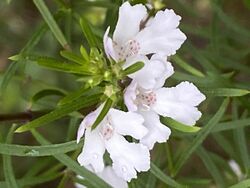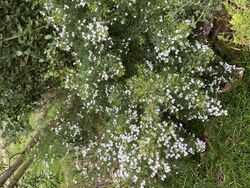Biology:Westringia longifolia
| Long-leaved westringia | |
|---|---|

| |
| Scientific classification | |
| Kingdom: | Plantae |
| Clade: | Tracheophytes |
| Clade: | Angiosperms |
| Clade: | Eudicots |
| Clade: | Asterids |
| Order: | Lamiales |
| Family: | Lamiaceae |
| Genus: | Westringia |
| Species: | W. longifolia
|
| Binomial name | |
| Westringia longifolia R.Br.[1]
| |
Westringia longifolia, commonly known as long-leaved westringia,[2] is a flowering plant in the family Lamiaceae and is endemic to southeastern Australia. It is a small shrub, with linear leaves and mostly white flowers.
Description
Westringia longifolia is a small shrub that grows to 1–3 m (3 ft 3 in–9 ft 10 in) high with a similar spread. The linear shaped green leaves are arranged in whorls of three, 12–35 mm (0.47–1.38 in) long, 1–2 mm (0.039–0.079 in) wide, more or less flat, margins smooth, both surfaces with occasional hairs or smooth, and the petiole 1–1.7 mm (0.039–0.067 in) long. The flowers are borne singly in the leaf axils, corolla 8–10 mm (0.31–0.39 in) long, lobes more or less triangular shaped, 1.6–2.8 mm (0.063–0.110 in) long, 0.9–1.2 mm (0.035–0.047 in) wide, mostly white or occasionally mauve with spots purple or light brown and silky inside. The green calyx are smooth or with sparse hairs on the outer surface and bracteoles 1–2 mm (0.039–0.079 in) long. Flowering occurs mostly from July to December[2][3][4][5]
Taxonomy and naming
Westringia longifolia was first formally described in 1810 by Robert Brown and the description was published in Prodromus florae Novae Hollandiae.[6][7]The specific epithet (longifolia) means "long leaved".[8]
Distribution and habitat
Long-leaves westringia grows in gullies, near streams on sandy or loamy soils north of Mittagong, scattered throughout Sydney and the Central Tablelands.[2][5]
References
- ↑ "Westringia longifolia". Australian Plant Census. https://biodiversity.org.au/nsl/services/apc-format/display/110117.
- ↑ 2.0 2.1 2.2 "Westringia longifolia R.Br.". PlantNET - New South Wales Flora Online. Royal Botanic Gardens & Domain Trust, Sydney Australia. https://plantnet.rbgsyd.nsw.gov.au/cgi-bin/NSWfl.pl?page=nswfl&lvl=sp&name=Westringia~longifolia.
- ↑ "Flora of Victoria". Royal Botanic Gardens Victoria. https://vicflora.rbg.vic.gov.au/flora/taxon/09132770-5090-484b-b499-6e2f1a7b5687.
- ↑ "Taxonomy browser (Westringia longifolia)". National Center for Biotechnology Information. https://www.ncbi.nlm.nih.gov/Taxonomy/Browser/wwwtax.cgi?mode=Info&id=798125&lvl=3&lin=f&keep=1&srchmode=1&unlock.
- ↑ 5.0 5.1 Fairley, Alan; Moore, Philip (1989). Native Plants of the Sydney Region. Sydney: Kangaroo Press. p. 296. ISBN 0864172613.
- ↑ "Westringia longifolia". Australian Plant Name Index. https://biodiversity.org.au/nsl/services/rest/instance/apni/541879.
- ↑ Brown, Robert (1810). Prodromus florae Novae Hollandiae et insulae Van-Diemen, exhibens characteres plantarum quas annis 1802-1805. London. p. 501. https://www.biodiversitylibrary.org/item/29583#page/369/mode/1up.
- ↑ Sharr, Francis Aubi; George, Alex (2019). Western Australian Plant Names and Their Meanings (3rd ed.). Kardinya, WA: Four Gables Press. p. 242-243. ISBN 9780958034180.
Wikidata ☰ Q15375487 entry
 |


